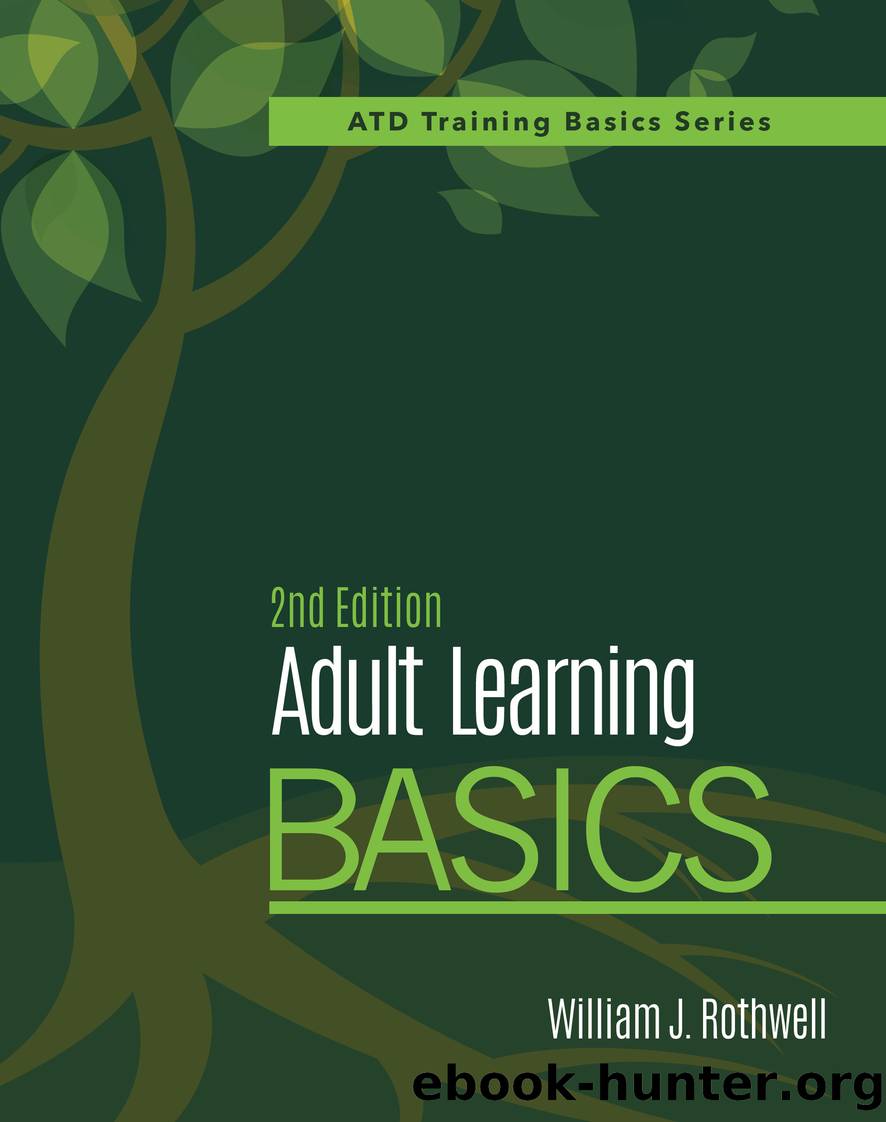Adult Learning Basics by William Rothwell

Author:William Rothwell [William Rothwell]
Language: eng
Format: epub
Publisher: Association for Talent Development
Published: 2020-09-28T16:00:00+00:00
How Learning Science Affects What Is Known About the Brain and the Learning Process
The human brain is a marvelous creation. And yet, according to some estimates, computers will have reached the ability to simulate human thought by about 2020, if present trends continue (Moravec 1997). By 1997, IBM’s Deep Blue Supercomputer was good enough to best reigning World Chess Champion Garry Kasparov.
About the size of a cauliflower head, the brain regulates body chemistry, controls the body’s movement, handles automatic functions such as breathing, and allows human beings to think and feel. Composed of about 100 billion cells called neurons, the brain functions through electrochemical signals. Most people know that the brain consists of such basic parts as a medulla (at the top of the spinal cord), the cerebellum, and cerebrum or cortex. The medulla regulates automatic body functions such as heart rate and breathing, the cerebellum helps coordinate movement of the limbs, and the cerebrum is the center of thought and of important senses. There are, of course, many other parts to the brain, all commonly thought to control different human functions.
The brain is also commonly divided by a big fold in the middle that creates a right side and a left side. These are associated with different aspects of thought. The left brain controls reason and analysis; the right brain is the center of creative thinking and feeling. The left side of the body is wired to the right side of the brain; the right side of the body is wired to the left side of the brain. Roger Sperry conducted groundbreaking research on the two parts of the brain. He conducted experiments with an individual who lost half of his brain. The left side of the brain tends to be fact-oriented, relies on logic, uses words, and is present- and past-oriented. The right side of the brain relies on feelings, focuses on the big picture (not details), and is present- and future-oriented.
Awareness of brain architecture provides only a partial understanding of how the brain works. Since the brain functions through electrochemical signals, brain chemistry is essential to an awareness of how the brain works. The study of brain chemicals is often associated with brain neurochemistry. A few examples of neurochemicals include:
• Dopamine, a neurotransmitter that affects emotional functions
• Serotonin, which affects moods and sleep
• Acetylcholine, which assists motor function
• Nitric oxide, a gas that can also serve as a neurotransmitter
How an Understanding of the Brain May Influence Training Practice
Talent developers should remain attuned to advances in brain chemistry and physiology to be aware of how that information may increase the efficiency and effectiveness of training. People exercise their bodies to get in shape. They can also exercise their brains to attune their attention, memory, mood, sleep, and even their learning. According to a research study of 700 Chicago residents with an average age of 80, published in an online edition of Neurology, researchers found that older people who engage in stimulating mental activities such as chess or reading newspapers can reduce the risk of Alzheimer’s.
Download
This site does not store any files on its server. We only index and link to content provided by other sites. Please contact the content providers to delete copyright contents if any and email us, we'll remove relevant links or contents immediately.
API Testing and Development with Postman by Dave Westerveld(1847)
2021 Beginners Guide to Python Programming Language: A Crash Course to Mastering Python in One Hour by Elmer Gary & Elmer Gary(1835)
Learning C# by Developing Games with Unity 2020 by Harrison Ferrone(1605)
Software Architecture for Busy Developers by Stéphane Eyskens(1519)
Machine Learning for Algorithmic Trading by Stefan Jansen(1512)
Hands-On ROS for Robotics Programming by Bernardo Ronquillo Japón(1483)
Delphi GUI Programming with FireMonkey by Andrea Magni(1355)
Cloud Native with Kubernetes by Alexander Raul(1309)
Game Development Projects with Unreal Engine by Hammad Fozi & Goncalo Marques & David Pereira & Devin Sherry(1298)
Automate It with Zapier by Kelly Goss(1256)
Software Architecture Patterns for Serverless Systems by John Gilbert(1254)
Datadog Cloud Monitoring Quick Start Guide by Thomas Kurian Theakanath(1236)
Practical System Programming for Rust Developers by Prabhu Eshwarla(1233)
Practical Node-RED Programming by Taiji Hagino(1221)
Mastering React Test-Driven Development by Daniel Irvine(1207)
Delphi Programming Projects by William Duarte(1195)
Learn Spring for Android Application Development by S. M. Mohi Us Sunnat(1167)
Ghidra Software Reverse Engineering for Beginners by A. P. David(1166)
Developing Multi-Platform Apps with Visual Studio Code by Ovais Mehboob Ahmed Khan & Khusro Habib & Chris Dias(1163)
